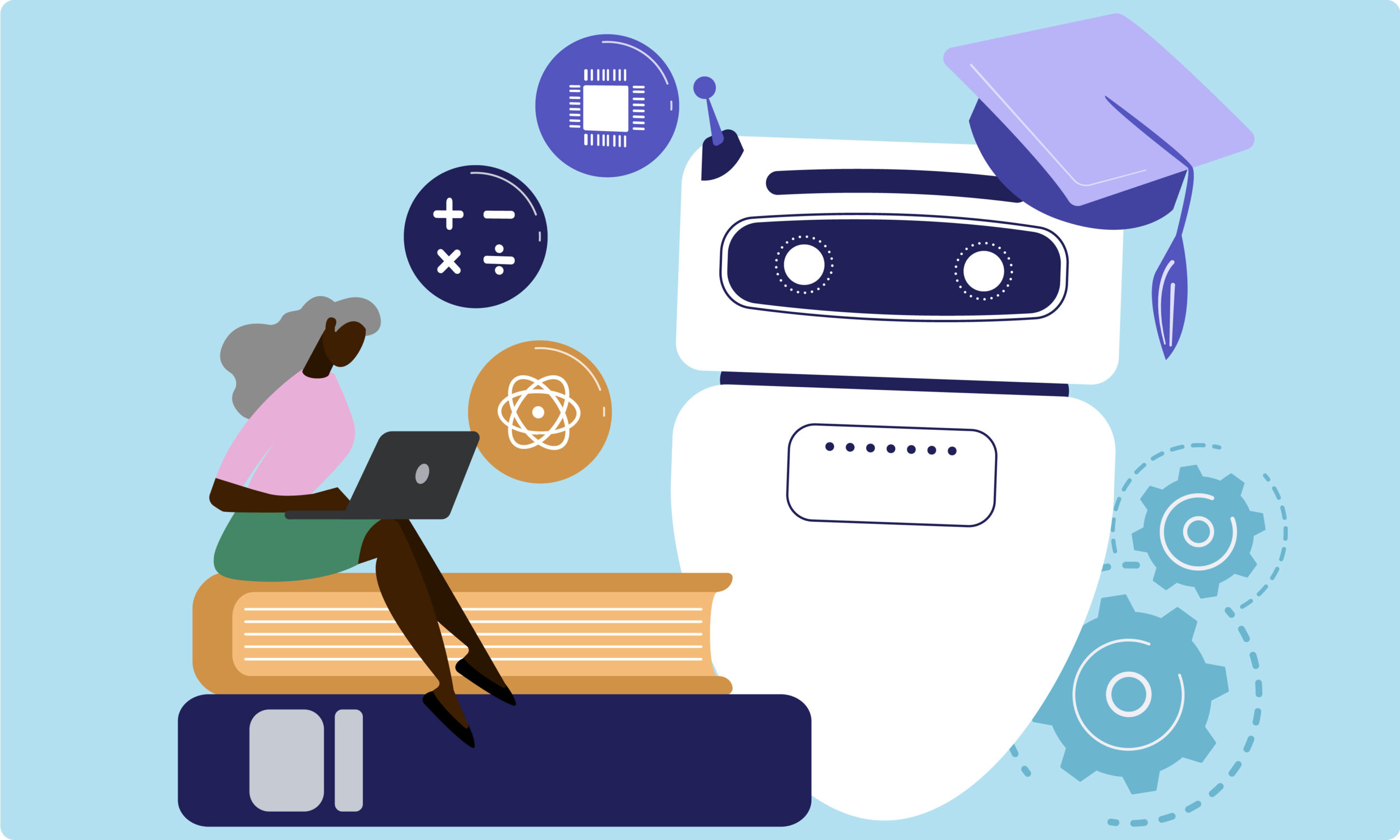What Is AI in Recruiting?

When we’re talking about AI in recruiting, we mean the use of artificial intelligence (AI) in the end-to-end hiring process – tools that help recruiters hire faster, smarter, and (ideally) with less bias.
AI can be used in every stage of the process, from sourcing and screening candidates, to analyzing resumes and job applications, conducting assessments, and predicting candidate success and cultural fit.
If you are still on the fence about using AI-based tools, read on to discover why now is the time to hop on the AI bandwagon.
Quick hiring: Inefficient recruiting processes can mean losing top candidates to the competition. The more time-consuming your hiring process, the more offers you’ll compete with, making it harder to secure great-fit talent. AI can speed up the process without compromising quality.
Enhanced efficiency: By leveraging AI in your recruitment process, you can automate time-consuming tasks that keep teams from building relationships and spend more time focusing on top candidates, resulting in a more efficient and effective recruitment process.
Accurate matching of candidate qualifications: AI can quickly analyze resumes and applications to find the best matches for your job openings, saving time and ensuring you find the right candidates faster.
Improved engagement: By personalizing interactions and providing a seamless experience, AI helps candidates feel valued and excited about joining your team. This positive experience carries over into their roles, boosting engagement and retention.
Reduction in bias: You can use AI-powered tools to screen candidates objectively, focusing solely on qualifications. Artificial intelligence can also help identify and remove biased language from job descriptions, ensuring fairer treatment for applicants.
Personalization: From personalized job recommendations based on candidate profiles to tailored communication, AI ensures a more engaging and effective recruitment journey. Additionally, it can personalize onboarding processes, ensuring new hires feel valued and supported from day one. SHAZAM!
In a nutshell, leveraging AI in recruiting means organizations can achieve a more efficient, effective, and fair hiring process… when it’s done right. Now, let’s get on to the good stuff.
Key Questions to Ask About AI in Your Recruitment Tech Stack
Crafting the right questions is super important, but not necessarily easy – especially when we’re getting into AI! Whether you’re evaluating potential new vendors, or checking in with your existing partners, we’ve compiled a pretty thorough list of questions that will help you understand how their AI is used. The goal? To ensure that the artificial intelligence powering your recruitment tech stack is aligned with your organizations’ needs, business objectives, and values.
AI capabilities
- What specific AI technologies do you use in your recruitment solution (e.g., machine learning, natural language processing, predictive analytics)?
- What types of AI systems and algorithms are used, and for what purposes?
- Can you provide evidence or case studies demonstrating the accuracy and effectiveness of your AI models?
- How do you measure and ensure the accuracy of your AI systems over time?
- How adaptable is your AI to changes in our specific industry or business model?
- Can your AI models be customized to meet our unique needs?
Large language models
- What specific large language models (LLM) do you use in your solution(s) (e.g., GPT-4, BERT)?
- How do you make sure the info your LLM provides is accurate and relevant?
- What mechanisms are in place to handle inaccuracies or inappropriate content generated by LLMs?
- Please provide case studies or examples of how LLMs have improved recruitment processes for your clients.
- How do you address and prevent potential biases in LLM outputs?
- How do you ensure that LLMs are updated and maintained to reflect the latest knowledge and best practices in recruitment?
- Can you customize your LLMs to our specific recruitment needs and industry requirements?
Generative AI
- What gen AI technologies are incorporated into your solutions, and what specific functions do they perform (e.g., resume generation, candidate outreach)?
- How do you make sure that the content generated by your AI systems is accurate, relevant, and free from biases?
- Can you provide examples of how gen AI has been successfully implemented for your clients?
- What safeguards do you have in place to prevent the generation of inappropriate or harmful content?
- How do you handle user feedback and corrections to improve the performance and reliability of gen AI systems?
- What measures are taken to ensure that generative AI outputs comply with legal and ethical standards in recruitment, across the markets we operate in?
- How do you balance the use of gen AI with the need for human oversight and decision-making in recruitment processes?
Data suitability and objectivity
- Why are the chosen data points used to train the models? Is all of it relevant for the use case?
- What sources of data are used and why?
- How is the data checked for bias before it is used for training models?
- Are there data points that may potentially cause bias, such as gender, race, and ethnicity? How are these handled and why are these in the model?
- Is the data representative of the distribution in the real world?
Ethical AI
- How do you identify and mitigate bias in your AI models, with respect to race, gender, age, and/or other protected attributes?
- Can you provide examples of steps taken to ensure fairness in your AI systems?
- Do you have documentation on how you have protected or tested to ensure AI does not introduce bias or unfairness toward one group of people?
- How transparent are your AI models and decision-making processes?
- Do you offer explainability features that allow users to understand how decisions are made?
- What measures do you have in place to ensure that your AI systems are transparent and explainable?
- What third parties do you work with to audit your models and training data?
- Can you share the results of any bias audits or reviews?
- How do you ensure that your AI systems are aligned with ethical and social values, and do not harm individuals or society as a whole?
Explainable AI
- How is the data segmented (e.g., by geography, industry)?
- How is the data stored and connected? Is it in tables, documents, or graphs?
- How do you maintain data quality? Is it complete, fresh, and deduplicated?
- Why were certain models chosen over other models? What tests were done to choose these particular models?
- How and how often are the models checked for bias? Are there humans in the loop?
- When there’s feedback about biases or errors with the recommendations, how will this be taken into account in the model? What procedures do you have in place to ensure that this has been fixed?
- Do you have documentation on how you have tested your AI to ensure it doesn’t introduce bias or unfairness toward one group of people?
- How does audit compliance actually work?
- What happens when the compliance still fails after an audit?
- Can you give a sample evaluation data of any AI model and sample audit report to understand the format of the data to be shared and how the audit report is linked with the sample evaluation data provided?
- Do you price separately for the evaluation data?
User experience and interaction
- How user-friendly are your AI-powered features?
- Do you offer training or support to help our team effectively use your AI tools?
- How do you incorporate user feedback into the development and improvement of your AI systems?
- Where does it add value, and how does it enable users to achieve their goals more effectively than without the AI?
- How much influence does the user have over the model?
- How does user interaction and feedback on the models impact the model training?
- How is the AI explained to users? Is it clear on why the AI made recommendations, and the key factors driving recommendations? Is it easily understandable and reassuring?
- How do you ensure that users are fully informed about the use of AI systems and their potential impact on their data privacy and rights?
Implementation, adoption, and satisfaction
- How is your solution actually implemented? Do you have any use cases? Will the experience of implementation be quick and easy?
- Is there a low barrier to usage? Is the AI intuitive enough to be a natural part of the workflow?
- How happy are your current customers? Is the AI not only working but delighting users?
Integration and scalability
- How easily can your AI systems integrate with our existing recruiting software and systems?
- What is the process and timeline for integration(s)?
- Can your AI solutions scale with our company as it grows?
- What are the costs and technical requirements associated with scaling?
Data privacy and security
- What types of data does your AI system collect and process?
- How do you ensure the privacy and security of personal data collected and processed by your AI systems?
- Do you use any client data for training your AI model?
- How long do you retain clients’ data before purging it?
- How do you ensure that your AI systems comply with applicable legal and regulatory requirements, such as data protection and anti-discrimination laws?
- Does your company conduct regular audits and evaluations of its AI systems to ensure compliance with ethical and legal standards?
- Is data encryption important regardless of whether the data includes personally identifiable information (PII)?
- What consent was obtained when the data was used or acquired?
- How is data per customer stored and used between other customers?
- What steps are taken to ensure the data is securely stored and cannot be amended or stolen?
- What steps are taken to ensure the models cannot be interfered with?
Governance and compliance
- How is the governance platform different from an AI tracker? Do we get an AI tracker by default when we onboard the governance platform?
- What are the protected attributes per legislation that we need to know? For example, what are the protected attributes under the EU Act and NIST?
- How does the pricing change if we have more than one AI model solving the whole problem?
Terminology – a Not-So-Brief Look
There’s a LOT of info out there around AI – we think it’s more than fair to say it has grown exponentially over the last couple of years. Here are the top terms we think you should be familiar with as you dive into conversations with potential or current vendors.
A/B testing
A method to compare two versions of something to see which performs better.
Algorithm
A set of rules or procedures for solving a problem or performing a task, often used in AI for data processing and model training.
Application programming interface (API)
A set of protocols and tools for building software and applications, allowing different systems to communicate, often used to integrate AI functionalities.
Artificial intelligence (AI)
The simulation of human intelligence processes by machines, especially computer systems, including learning, reasoning, and self-correction.
Artificial neural network (ANN)
A computational model inspired by the way neural networks in the human brain process information, used in deep learning.
Autoencoders
Neural networks that compress data and then reconstruct it to learn efficient representations.
Automated sourcing
The use of AI and automation tools to find and gather potential candidates or resources from various sources without manual effort.
Bias in AI
Refers to the systematic error in AI systems that leads to unfair outcomes, often due to biased training data.
Bidirectional encoder representations from transformers (BERT)
A deep learning model by Google that understands language context from both directions in a sentence.
Big data
Extremely large data sets that may be analyzed computationally to reveal patterns, trends, and associations, often used in AI for training models.
Computer vision
A field of AI that enables machines to interpret and make decisions based on visual input, such as images or videos.
Data analysis
The process of examining data to extract useful information and insights.
Data engineering
Building systems to collect, store, and manage large datasets for analysis.
Data mining
The practice of discovering patterns and insights from large datasets.
Data visualization
Graphical representation of data to make it easier to understand.
Data wrangling
The process of cleaning and transforming raw data into a usable format.
Deep learning
A subset of ML that uses neural networks with many layers (deep networks) to analyze various levels of data abstraction.
Edge AI
The deployment of AI algorithms on devices at the edge of a network (e.g., smartphones, IoT devices) rather than in centralized data centers, enabling faster decision-making.
Explainability
The extent to which the internal mechanics of an AI system can be explained in human terms, critical for trust and accountability.
Exploratory data analysis (EDA)
A method to summarize and visualize data to discover patterns and anomalies.
Generative pre-trained transformer (GPT)
A language model by OpenAI that generates human-like text based on deep learning.
Large language models
Advanced AI models trained on vast amounts of text data, capable of understanding, generating, and responding to human language with high accuracy.
Machine learning (ML)
A subset of AI where machines learn from data without being explicitly programmed, using algorithms to identify patterns and make decisions.
Model validation
The process of evaluating a model’s performance using a separate dataset to ensure it generalizes well to new data.
Natural language processing (NLP)
A field of AI that enables computers to understand and respond to human language.
Neural network
A computer system modeled on the human brain’s network of neurons, used to recognize patterns and classify data.
Overfitting
A modeling error in ML where a model is too closely fitted to a limited set of data, leading to poor generalization to new data.
Personalized search
A search process tailored to an individual’s preferences, behaviors, or past interactions, providing more relevant and customized results.
Recommendations
Suggestions generated by AI based on user behavior, preferences, or patterns, aimed at helping users discover relevant content, products, or actions.
Reinforcement learning (RL)
A type of ML where an agent learns to make decisions by taking actions in an environment to maximize cumulative reward.
Regressions
Statistical methods to estimate relationships between variables for prediction.
Simulations
Models that replicate system behavior to study performance in various scenarios.
Statistical analysis
The process of analyzing data to identify trends and relationships.
Statistical models
Mathematical representations that predict or understand relationships in data.
Supervised learning
A type of ML where the model is trained on labeled data, meaning the input comes with corresponding correct output.
Training data
The dataset used to train an AI model, helping it to learn and make predictions or decisions.
Underfitting
The opposite of overfitting, where a model is too simple to capture the underlying trends in the data.
Unsupervised learning
A type of ML where the model is trained on unlabeled data and must find patterns or structure in the input
Conclusion
From programmatic job advertising to chatbots, understanding how artificial intelligence is used by your prospective or current vendors is incredibly important. AI is – or should be – a tool to help both recruitment pros and candidates navigate the process with ease, taking care of mundane tasks while also offering a more personalized experience and (ideally) reducing bias.
As you use these questions to better understand how AI can be (or is) used in your recruitment tech stack, remember that the goal is not only to find a vendor with the right technical capabilities but also one that offers you true partnership, transparency, and shared growth.
May your conversations and deeper understanding lead to successful recruiting campaigns and fruitful collaborations!














